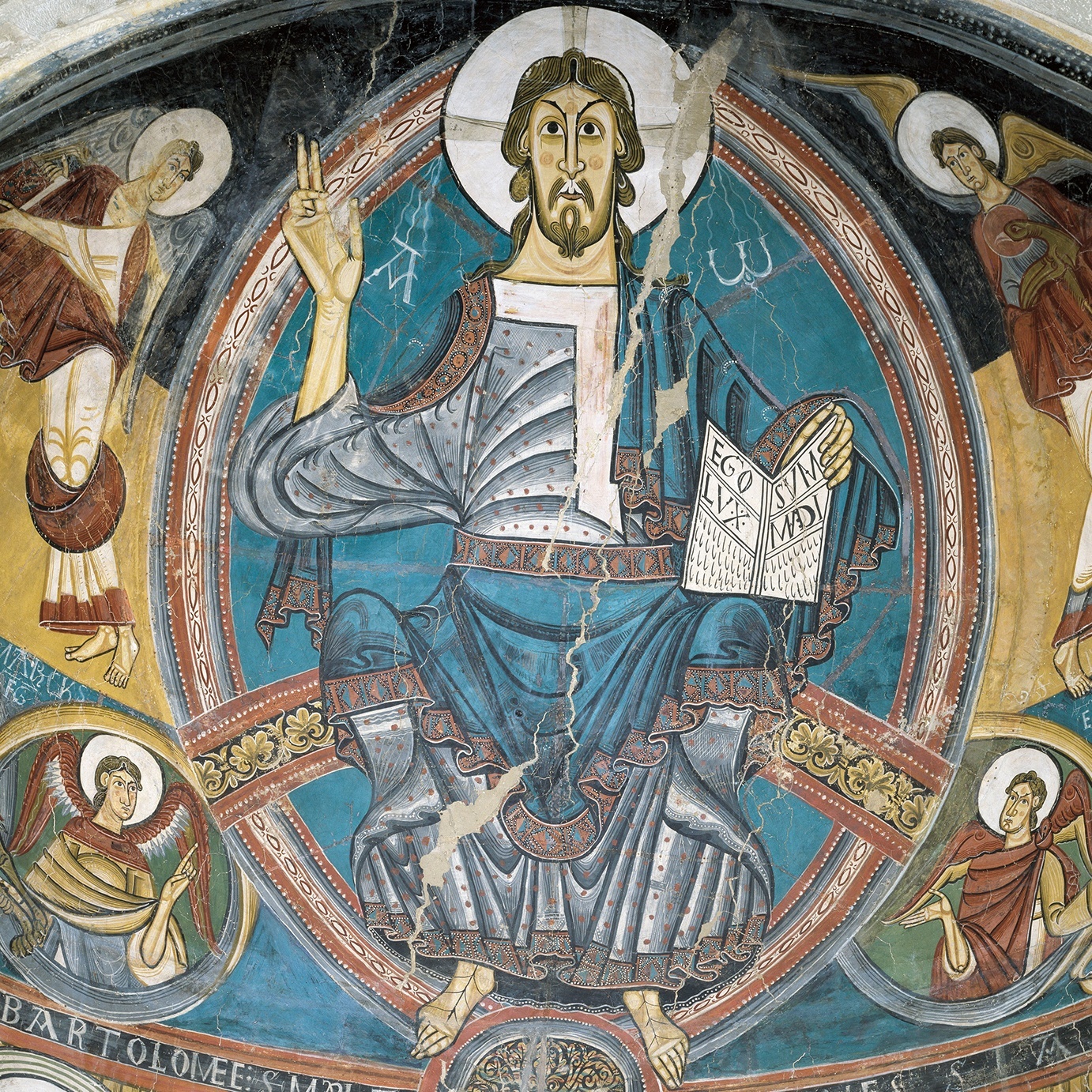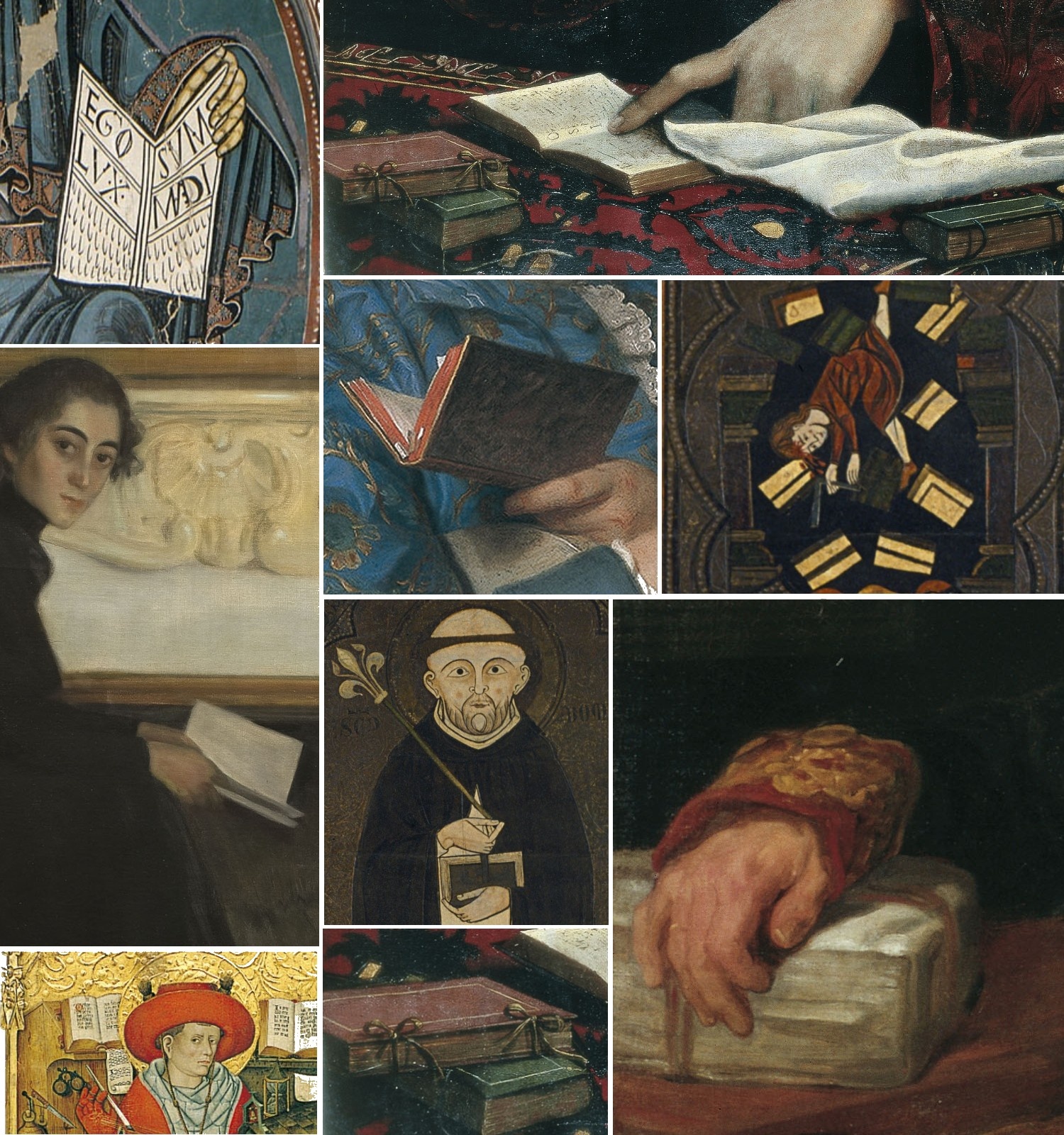-
The Altarpiece of Saint Dominic of Guzmán
In the 13th century the first so-called mendicant orders were founded: the Dominicans and the Franciscans, which as well as religious vows practiced the vow of poverty. Furthermore, they respectively fought against the Cathars in France and the north of Italy.
In this altar frontal, Saint Dominic, founder of the Dominicans or preachers, holds in his right hand a new monastic rule and a lily, allegorical of his chastity and the worship of the Virgin Mary. In the upper left compartment of the frontal, there is a representation of the scene of the Test of Fire, where the burning of the books of the Cathars figures, which at the time were considered heretical, and the miraculous salvation of the Gospels, which is also allegorical of the book of the rules of the Dominicans.
In the same way that the book in the Romanesque plastic art was sacred, the Word of God or transmitted by God, now, depending on the images, goes beyond this dimension and also in the fact that it also contains heretic messages, it should be destroyed.
-

Apse of Sant Climent de Taüll
The Christ in Majesty holds a book in the left hand with the legend “EGO SUM LUX MUNDI”, that is to say, ‘I am the light of the world, as it was habitual in Romanesque iconography. These words are of the evangelist of Saint John. The light is interpreted as the Verb, the Word that gives life and is the beginning of everything; it is also the word of the prophets which illuminated the apostles, the truth that the knowledge of God reveals to us. On other occasions, such as in the Canopy of Tavèrnoles, the inscription that appears in the book held by Christ in Majesty is another: “EGO SUM VIA VERITAS ET VITA”, ‘I am the truth and the life’. This representation of Christ in Majesty with the book in the left hand and surrounded by symbols of the four evangelists doesn’t only belong to mural painting, but also appears in painting of the altarpiece, as can be seen in the Canopy of Tost.
-

The book and reading in the collections of the museum
Has the concept of the book changed over time? This itinerary lets you see how in the Romanesque it is a symbol of what is holy, which in the Gothic was to become an appreciated object and even censurable. During the Renaissance and the Baroque, from the moment of the invention of the printing press onwards, it became increasingly affordable, until becoming an object that communicated wisdom and represented the dignity of a profession, to symbolising the prestige or social advancement, ending up becoming a reason for pleasure and pastimes.
See the album of the museum devoted to the reading on Pinterest:
Follow Museu Nacional d'Art de Catalunya's board Llibres a la col·lecció on Pinterest.
Follow Museu Nacional d'Art de Catalunya's board Ex-libris on Pinterest.
-
Browsing the Album
In the nineteenth century, a new bourgeoisie model of society is established, in which everything that is private, intimate or individual is highly considered. The book that Teresa Masanés, the artist’s wife, is looking at is different from the other books of the itinerary. It is an album, a book consisting of blank pages for storing photographs, stamps, for collecting autographs, poems, drawings, etc. Once more, books are an element of entertainment, of dolce far niente, though in this case the reading is not something written by someone else, but little pieces of the depicted woman’s private life. What there is in those sheets is not displayed. It is Teresa’s intimate area.
-
Jaume Ferrer, Saint Jerome, Saint Martin of Tours, Saint Sebastian and the Calvary
The central compartment of this altarpiece is presided by Saint Jerome, dressed as a Cardinal, in his office, surrounded by books and writing instruments. Saint Jerome is a writer and translator of the Bible into Latin, the Vulgata, and he appears in his working environment. As a writer, on the left, there appears his Epistles, and as a translator, on the right, the Bible.
On other occasions, we can see the figure of a penitent Saint Jerome, as in the altarpiece that the Museu Nacional conserves, the work of the Master of Seu d’Urgell. In this case, even though the setting in which it is represented is the desert where he went to meditate and do penitence and he isn’t wearing Cardinal’s clothing, he continues to be surrounded by books, fitting in with his condition of writer and translator.
-
Maurice Quentin de La Tour, Pierre Louis Laideguive
In 18th century France, the book became a companion of distraction of aristocrats and the wealthy classes, such as the notary Pierre Louis Laideguive, who must have read to train himself and for passing the time. He shows us a book that he must have read habitually because the notes he made were emphasised so as to retrieve the readings that interested him.
Possessing books in that period was also a sign of prestige, as we can see in the Portrait of Francesc Bofarull, by Pere Pau Montaña.
-
Saint John of the Deposition of Erill la Vall
Saint John, with a veiled hand in token of respect, holds the book written by his evangelist in his left hand. As one of the Four Evangelists, the figure of Saint John also appears in the Tetramorph, in which the symbols of the Four Evangelists, often with the Gospel they wrote in the hand, surrounding Christ.
On other occasions the ones holding the book in the hand are the Bishops, as on the Altar of Tavèrnoles, as trustees of the teachings of the book of Christ transmitted through the four gospels, and as representatives on Earth of the word of God.
Saint John didn’t only write the gospel, but was also author of the Book of Apocalypse, that he wrote on the island of Patmos, in which he announced the second coming of Christ. In Theophany, the book being held could represent the Apocalypse. -
Santiago Rusiñol, Romantic novel
Reading we have already seen can also be an act of distraction, to pass the time. This painting by Santiago Rusiñol shows this, in which we can know what topic has been chosen by the reader due to the clue given by the painter: the Romantic novel. Reading as a distraction is also presented to us by Martí i Alsina in la Migdiada (The Nap).
Other artists, such as Joan Llimona, distinguished representative of the Cercle Artístic de Sant Lluc, is inclined towards another type of reading: that of pious books, those that talk of the Christian values, as we can see in Reading
-
Sebastiano del Piombo, Vittoria Colonna (?)
The books that surround the woman portrayed talk to us, surely, of her condition as poet. She could possibly be Vittoria Colonna, friend and confidante of Michael Angelo Miquel Àngel. At other times she is identified with her friend and contemporary Giulia Gonzaga.
What we can be sure about is that she is a refined and cultured lady from 16th century Venice, and a lover of literature. At the same time, however, the position and gesture of the portrayed lady denotes enough ambiguity to be able to speak about a courtesan with extensive knowledge.
-
Vicente López, Portrait of the Marquis of Labrador
The book doesn't only reveal the prestige of the person portrayed, but often talks to us about his or her profession. Pedro Gómez-Havela Labrador, Marquis of Labrador, diplomat by career and ambassador in various Spanish diplomatic legations, appears with a bundle of documents belonging to his profession. In other portraits, as the one one done by Bernat López of José María Díez de Aznar, adviser to the Kings Carles IV and Ferran VII, the type of document that accompanied the characters was a personal letter, which appears closed so that they can't read it.
Museu Nacional d'Art de Catalunya
Mobile footer
- Legal notice
- Buy tickets
- Palau Nacional, Parc de Montjuïc
- 93 622 03 60
- Rates for Digital Images









